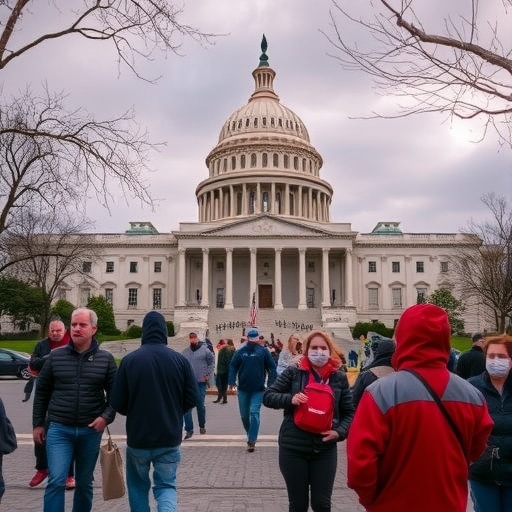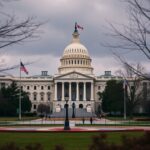In a stark reminder of political gridlock’s human cost, the ongoing government shutdown has now stretched into its third week, leaving over 800,000 Federal workers without paychecks and pushing families to the financial edge. As Congress remains deadlocked on funding disputes, the ripple effects are felt nationwide, from delayed airport screenings to stalled food safety inspections, highlighting the shutdown’s devastating toll on essential services and everyday Americans.
- Families Scrambling: Personal Hardships of Unpaid Federal workers
- Critical Delays: Essential Services Hamstrung by the Shutdown
- Economic Fallout: Broader Financial Impact Sweeps the Nation
- Voices Rising: Calls for Action from Workers and Lawmakers
- Outlook Uncertain: Potential Resolutions and Long-Term Reforms
Families Scrambling: Personal Hardships of Unpaid Federal workers
For Sarah Jenkins, a 42-year-old IRS auditor in Washington, D.C., the shutdown isn’t just a headline—it’s a daily battle against eviction notices and empty refrigerators. Like hundreds of thousands of Federal workers, Jenkins hasn’t seen a dime from her government salary since December 22, when the shutdown began over disagreements on border wall funding. “I’ve dipped into savings I didn’t know I had, and now that’s gone,” she told reporters last week, her voice cracking with exhaustion. “My kids ask why we can’t buy their favorite cereal anymore, and I don’t have an answer.”
This story is far from unique. According to the Office of Personnel Management, approximately 800,000 federal employees are affected, with about half furloughed and the other half working unpaid in critical roles. The financial impact is immediate and severe: a recent survey by the National Treasury Employees Union revealed that 70% of respondents have already maxed out credit cards or taken out loans to cover basics like rent and utilities. In high-cost areas like the D.C. metro region, where average rents hover around $2,000 monthly, the strain is amplified. One Virginia-based park ranger, speaking anonymously, shared how he’s rationing gas to commute to his unpaid job maintaining national monuments. “We’re working for free, hoping for back pay, but what if this drags on?” he asked.
The psychological toll is equally alarming. Mental health experts, including Dr. Elena Ramirez from the American Psychological Association, note a surge in anxiety and depression among affected families. “Federal workers are used to stability; this shutdown shatters that illusion,” Ramirez explained in a recent interview. Support hotlines have reported a 40% increase in calls from government employees seeking financial counseling, underscoring the emotional weight of the crisis.
- Key Statistics on Worker Hardships:
- Over 800,000 federal workers impacted, per OPM data.
- 50% of affected employees are working without pay.
- 70% have resorted to debt, according to union surveys.
- Expected back pay could total $3 billion once resolved.
Communities are stepping up where the government can’t. Food banks in Maryland and Virginia have seen a 25% uptick in visits from middle-class families, a demographic rarely seen in such numbers. Local charities, like the Capital Area Food Bank, distributed an extra 100,000 meals in the past two weeks alone, with executive director Nate Klein attributing the surge directly to the shutdown. “These are professionals—teachers’ spouses, engineers—who never imagined needing help like this,” Klein said.
Critical Delays: Essential Services Hamstrung by the Shutdown
Beyond personal woes, the shutdown is crippling essential services that Americans rely on daily. At major airports, TSA screeners—many of whom are federal workers toiling unpaid—are causing longer lines and heightened frustrations. The Transportation Security Administration reports that wait times at hubs like Atlanta and Los Angeles have doubled, with some travelers facing up to two-hour delays. “Security is compromised when staff are overworked and underpaid,” warned aviation expert Tom McGinn, who has tracked similar disruptions in past shutdowns.
The FDA’s food inspection teams, reduced by 40% due to furloughs, have postponed routine checks on imports, raising alarms about potential health risks. In one alarming case, a shipment of contaminated produce from abroad sat unchecked for days, only cleared after private sector volunteers stepped in. “We’re playing catch-up on essential services that protect public health,” said FDA spokesperson Alex Rivera. The financial impact here extends to businesses: meat processors and dairy farms report losses in the millions from delayed approvals, with the U.S. Chamber of Commerce estimating a $1.5 billion hit to the economy per week of the shutdown.
Environmental protection is another casualty. The Environmental Protection Agency has halted monitoring of air and water quality in several states, leaving communities vulnerable. In Flint, Michigan, where water crises linger in memory, residents fear oversight lapses could exacerbate issues. “Federal workers in these roles aren’t just employees; they’re guardians,” said local activist Maria Gonzalez. Meanwhile, national parks remain open but understaffed, leading to increased vandalism and safety hazards—rangers report a 30% rise in incidents like unchecked wildfires in remote areas.
- Top Affected Essential Services:
- Airport security and air traffic control, impacting 2.5 million daily travelers.
- Food and drug inspections, delaying $10 billion in goods annually.
- Environmental monitoring, with 1,200 EPA staff furloughed.
- National park maintenance, serving 330 million visitors yearly.
The shutdown’s reach even touches veterans’ care. VA hospitals are operating with skeleton crews, postponing non-emergency procedures and extending wait times for benefits claims. Over 300,000 veterans could face delays in processing disability payments, according to the Department of Veterans Affairs. One Iraq War veteran, Army Sgt. Ret. David Lee, shared his frustration: “I fought for this country, and now the system I depend on is frozen because of Washington politics.” This sentiment echoes across the nation, fueling public outrage.
Economic Fallout: Broader Financial Impact Sweeps the Nation
The financial impact of the shutdown isn’t confined to federal workers; it’s a tidal wave crashing into local economies. Economists from the Brookings Institution project a $18 billion loss to GDP by the end of the month if the impasse continues, driven by reduced consumer spending from unpaid salaries. In shutdown hotspots like D.C., where federal jobs dominate, small businesses are reeling—restaurants and retailers report 20-30% drops in revenue as federal workers cut back on dining out and shopping.
Consider the case of Maria’s Diner in Arlington, Virginia, a staple for government commuters. Owner Maria Lopez has laid off three staff members and slashed hours. “My regulars, these federal workers, used to come in for lunch daily. Now, it’s ghosts,” she lamented. Nationally, the financial impact includes a spike in mortgage delinquencies; Fannie Mae data shows a 15% increase among federal employee households. Credit card companies like Capital One have extended hardship programs, waiving fees for affected cardholders, but experts warn of long-term credit score damage that could haunt workers for years.
States are feeling the pinch too. California, home to thousands of federal workers at bases like Edwards Air Force Base, anticipates a $500 million shortfall in tax revenue from slowed economic activity. Governors across party lines, including Democrat Gavin Newsom and Republican Ron DeSantis, have urged federal intervention, with Newsom allocating $100 million in state aid for impacted families. “This shutdown is federal dysfunction spilling over borders,” Newsom stated in a press conference.
Globally, the U.S. credit rating faces scrutiny. Moody’s Investors Service has flagged the prolonged shutdown as a risk factor, potentially raising borrowing costs for everyone. “The financial impact is like a slow bleed—insidious and far-reaching,” said economist Dr. Raj Patel from Harvard’s Kennedy School. Non-profits tracking poverty predict a 5% rise in food insecurity rates, disproportionately affecting children in federal worker households.
Voices Rising: Calls for Action from Workers and Lawmakers
As hardships mount, federal workers are no longer silent. Protests have erupted outside the Capitol, with unions organizing rallies that drew 5,000 participants last weekend. Chants of “Pay us now!” mingled with signs reading “Shutdowns Hurt Heroes,” referring to the essential personnel working unpaid. AFGE President Everett Kelley addressed the crowd: “These federal workers keep America running—from securing our skies to inspecting our food. It’s time lawmakers remember that.”
On Capitol Hill, bipartisan frustration simmers. Senate Minority Leader Chuck Schumer has proposed a clean funding bill, decoupled from immigration debates, but it faces resistance from President Trump’s allies. House Speaker Nancy Pelosi echoed the urgency: “Essential services are at risk, and so are lives. We must end this shutdown immediately.” Moderates like Sen. Susan Collins (R-ME) are pushing for compromise, suggesting phased funding to reopen agencies while negotiations continue.
Labor advocates point to historical precedents. The 2018-2019 shutdown, the longest on record at 35 days, cost workers an average of $5,000 each in lost wages. This time, with inflation and rising costs, the stakes are higher. The AFL-CIO has launched a “Shutdown Stories” campaign, collecting testimonials to pressure politicians. One viral video features a Coast Guard member explaining how unpaid status forced him to use a food pantry: “I protect our shores, but who protects my family?”
Public opinion polls reflect growing impatience. A Quinnipiac University survey shows 60% of Americans blame congressional Republicans for the stalemate, with 80% supporting back pay for federal workers. Bipartisan bills guaranteeing retroactive compensation have passed both chambers unanimously, offering a sliver of hope amid the chaos.
Outlook Uncertain: Potential Resolutions and Long-Term Reforms
As the shutdown grinds on, eyes turn to upcoming negotiations. White House officials hint at a possible deal by mid-January, tying funding to temporary border security measures, but skeptics abound. Treasury Secretary Steven Mnuchin has warned of debt ceiling complications if unresolved, potentially triggering another crisis. For federal workers, relief can’t come soon enough—many are weighing second jobs or even resignations, which could exacerbate staffing shortages in essential services.
Longer-term, experts call for reforms to prevent future impasses. Proposals include automatic continuing resolutions to avoid shutdowns or caps on their duration. The Congressional Budget Office estimates that recurrent shutdowns have cost the economy $11 billion since 2013, fueling demands for structural changes. Advocacy groups like No Labels advocate for a “grand bargain” on fiscal policy to sideline partisan fights.
For now, federal workers hold on, buoyed by community support and the promise of back pay. But as winter deepens and bills pile up, the financial impact underscores a painful truth: in the halls of power, real lives hang in the balance. Watch for developments as talks intensify, with the potential to restore normalcy or prolong the pain.










